The OnePlus 3T Review
by Brandon Chester on November 28, 2016 10:30 AM EST- Posted in
- Smartphones
- OnePlus
- OnePlus 3T
GPU Performance
Along with the 10% increase in peak CPU clock speeds, the version of Snapdragon 821 in the OnePlus 3T also increases the peak GPU frequency to 653MHz, up from 624MHz in the OnePlus 3. This is a relatively modest improvement, so the corresponding increase in performance will also be rather modest as well. In the interest of merely verifying that performance has improved as expected, I've run 3DMark Sling Shot and GFXBench Car Chase on the OnePlus 3T.
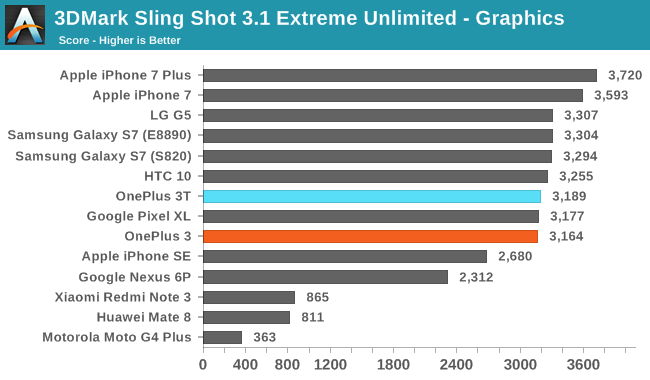

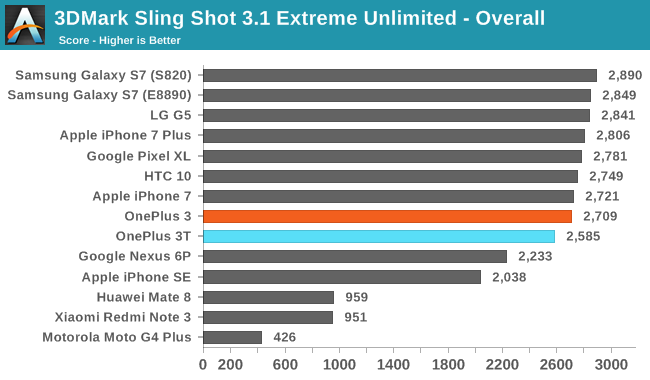
The 3DMark graphics test actually doesn't see much of an improvement on the OnePlus 3T. It may be that I simply got an exceptionally good score on the OnePlus 3, but it is interesting to see such a large gap in the physics test, which should favor the OnePlus 3T with its higher-clocked CPU cores.
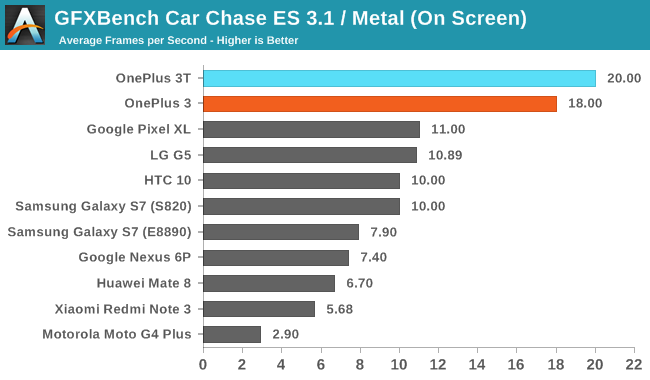

In GFXBench Car Chase the OnePlus 3T shows a performance uplift of around 10% compared to the OnePlus 3. This is slightly higher than expected, but due to the truncation of results in the latest GFXBench this may be slightly exaggerated, which tends to happen when comparing devices that differ in performance by only one or two frames per second.
NAND Performance
In our recent review of the Pixel XL one of the problems we ran into was that AndroBench had been broken by the adoption of file-based encryption (FBE) in Android Nougat. AndroBench is the benchmark we use to measure storage performance, and since that time it has been updated with a new version that works on devices that use FBE. However, the results are not comparable to results from AndroBench 4, so going forward we will be using the AndroBench 5 test with a new data set for device results.
As always, our storage test examines the performance for random reads and writes using a 4KB transfer size, and sequential reads and writes using a 256KB transfer size. These settings are chosen to match what actually occurs when an application performs IO operations. Only one IO thread is used, which again mirrors how applications are actually designed in order to reflect the performance that will be seen in real usage instead of reflecting potentially higher speeds that the hardware may be capable of, but that will almost never be encountered in an actual use case.
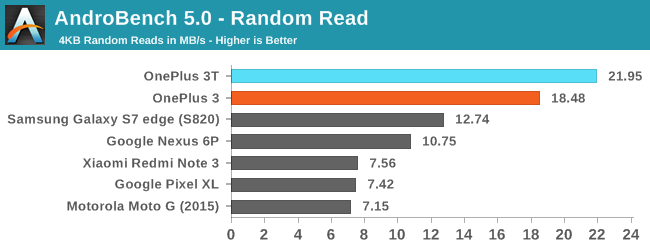
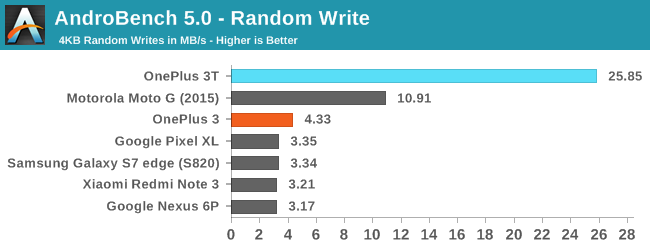
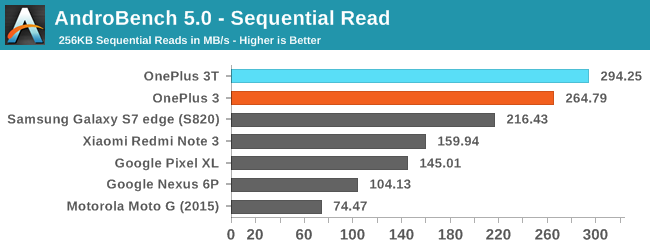
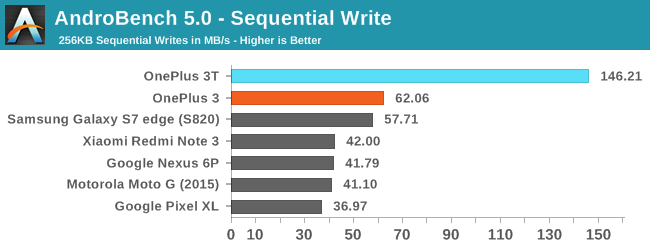
In Androbench 5 the OnePlus 3T tops the charts. However, it's important to recognize why this is, particularly where write speeds are concerned. Most smartphones we review have either 16GB or 32GB of internal memory. The OnePlus 3 has 64GB, and this OnePlus 3T unit is the flagship 128GB model. With flash memory, assuming that you have some density for a chip, increasing capacity is accomplished by increasing the number of chips. Because SSDs and other flash memory devices utilize parallel writes to improve performance, increasing the number of dies can allow for greater performance by increasing the number of writes that can happen in parallel.
In addition to the larger amount of internal storage, OnePlus has also adopted F2FS for the filesystem, which is another source of performance improvements, particularly in the case of random write speeds.
With that in mind, the results from AndroBench actually aren't that shocking. In the write tests the 128GB model of the OnePlus 3T is well ahead of every other device, including the 64GB OnePlus 3. Read performance is also improved compared to the OnePlus 3, but not to the same extent.










104 Comments
View All Comments
adityarjun - Monday, November 28, 2016 - link
"The only change that actually does impact the user in a visible and meaningful way is the improved battery life."And the fact that you can't game on it anymore apparently.
xenol - Monday, November 28, 2016 - link
Any samples of the pictures the camera takes?Ian Cutress - Monday, November 28, 2016 - link
As mentioned directly in the review, the 3T shares a number of identical parts and software elements. One of these is the camera. We've only focused on the main changes for this review, rather than reposting most of the OP3 review again. So refer to the OP3 review :http://www.anandtech.com/show/10411/the-oneplus-3-...
realbabilu - Tuesday, November 29, 2016 - link
No love for front camera upgrade samples? Selfies anyone.I hope their night scene for main camera have been a little bit better at 3T,
Ironchef3500 - Monday, November 28, 2016 - link
Anybody else disappointed at the Pixel performance?amdwilliam1985 - Monday, November 28, 2016 - link
Yep, I believe Anandtech is the only reputable website/source on the internet that didn't like the Pixel phones, everyone else is raving how great they are, including all the non-tech users. Well, I was so tempted to upgrade to Pixel XL after seeing all the youtube/website raves, thanks to Anandtech, I'm saving my money and going for the next version. I got a 6P, bought 2 pairs of dbrand skins on Black Friday, the new skins and Android 7.1.1 will make a new phone out of my 6P :)I guess Google is focusing on optimizing the user experience while everyone is still chasing after benchmarks(including Apple, T_T for Apple after Steve Jobs, next year Tim Crook will introduce 3 iPads with 4 iPhones for every possible market segmentation to make even more money that they'll never use).
Techgeek43 - Monday, November 28, 2016 - link
Brandon, great article, as always. One question I have, is it a mimo chip on the WiFi ? Does it have top speed of 433 or 867 ?Brandon Chester - Tuesday, November 29, 2016 - link
433Mbps. I've added that to the chart on the first page as well.Techgeek43 - Wednesday, November 30, 2016 - link
Thank youzepi - Monday, November 28, 2016 - link
Any change that Anandtech could take a look at OLED burn-in / durability issues? There is lot of talk about this and I've personally seen many oled phones / tablets in shops having clear burn-in issues, but afaik no big tech-site has done real reviews.Ie. source 1 and 2 year old used daily-driver OLED phones that you've reviewed earlier and run the display calibration benchmarks again. It'd be interesting to see how well Galaxy S5's and S6'es fare after being used 1-2 years in terms of max brightness, image retention and colour balance.
Obviously, it wouldn't hurt to run comparison measurements from a similarly aged LCD phone like iPhone 6 or something like that.